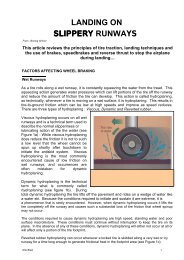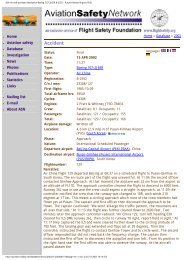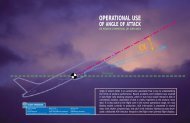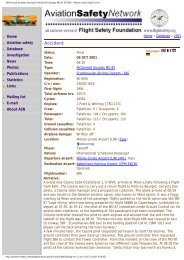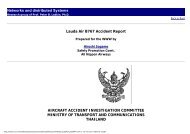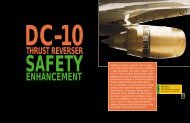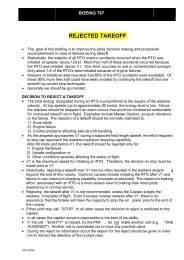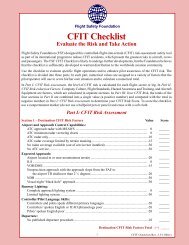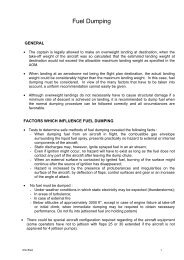Boeing 737-236 series 1, G-BGJL: Main document - Leonardo
Boeing 737-236 series 1, G-BGJL: Main document - Leonardo
Boeing 737-236 series 1, G-BGJL: Main document - Leonardo
Create successful ePaper yourself
Turn your PDF publications into a flip-book with our unique Google optimized e-Paper software.
A passenger from seat 6A saw a sheet of flame inside the cabin.It seemed to be near the centre of<br />
the aircraft and separatedthe front half from the back. Another passenger from 6B, afterseeing foam<br />
being sprayed over the fire on the left side of theaircraft, tried to move into the aisle but it was<br />
jammed withpeople and it was difficult to move. On turning he saw flamesshooting in through the<br />
side windows and up through the floorarea. The flames were several feet in length and continual.<br />
The fireman who, after rescuing the young boy, attempted to rescuethe man jammed in the<br />
overwing exit, reported feeling "dizzy"from the effects of the fumes and smoke. Comments on the<br />
effectsof the smoke outside the aircraft were made by many of those assisting,who complained of<br />
its effects on their throats and breathing.<br />
A British Airways coach had collected the crew of a Tristar aircraftwith the intention of taking<br />
them to their flight office afterclearing Customs. When the driver saw the aircraft on fire<br />
heinformed his passengers that he was taking the coach to assistat the accident. Upon arrival (at<br />
approximately 4 minutes afterthe aircraft stopped) the cabin crew immediately went to the<br />
assistanceof the survivors, many of whom ran towards the coach. The firstevacuees were in a state<br />
of shock, but dry, whereas those followingthem were blackened with smoke and wet with foam.<br />
Several stewardessesassisted a woman who was lying approximately 100 yards forwardof the<br />
aircraft and appeared unconscious. She was being givencardiac massage by a fireman. After<br />
resuscitation with oxygen,this passenger began to recover and a deep wound was found onthe back<br />
of her head. She was taken to an ambulance. A young girlof approximately 17 years, was also<br />
found in the grass forwardand to the left of the aircraft. Her face was black, hair wet,and her eyes<br />
"frosted over" with a white deposit. Shehad no signs of burning on her clothes.<br />
The crew members also assisted a young man of about 24 years,he was crouched on the grass and<br />
covered in soot. He was havingdifficulty in breathing and thick mucus was pouring from his<br />
noseand mouth. A stewardess hit him in the back, the practised methodof causing a cough reflex.<br />
As she did this, he started to coughand his breathing became easier.<br />
The TriStar crew members met both surviving cabin crew and assistedthem away from the aircraft.<br />
The British Airways coach was joinedby another three coaches from the Manchester Airport<br />
Authority.<br />
After some 40 survivors had been led aboard the British Airwayscoach, it left the scene at<br />
approximately 0725 hours for PierB, gate number 1 departure lounge where approximately 15<br />
BritishAirways cabin crew had set up chairs, blankets etc to receivethe passengers. The young boy<br />
pulled from the overwing exit wasgiven some treatment here for the burns to his hands, using afirst<br />
aid box from an adjacent aircraft. Another passenger whowas having difficulty breathing was given<br />
oxygen to ease her respiration.It was, however, quickly decided that this area was not suitablefor<br />
the condition of the survivors who were in a state of shock,and they were then taken on by the<br />
British Airways coach to WythenshaweHospital at 0745 hours, where staff were ready to receive<br />
them.<br />
The young boy, whose condition was deteriorating, was not takendirectly to the hospital, but was<br />
taken to the Fire Station ina catering van by a British Airways stewardess, where he was<br />
reunitedwith his father. The remaining survivors had been taken to thefire station crew room by the<br />
Manchester Airport coaches. Thesesurvivors were later taken to Wythenshawe Hospital. Many<br />
BritishAirways cabin crew staff stayed at Wythenshawe Hospital to consolethe survivors and also<br />
to take names and addresses for disseminationto relatives.<br />
A cabin seating plan showing which passengers used each exit andthe seat location of those who<br />
died is at Appendix 14.



